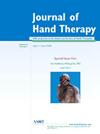Assistive technology on upper extremity function for stroke patients: A systematic review with meta-analysis
IF 2.1
4区 医学
Q2 ORTHOPEDICS
引用次数: 0
Abstract
Background
In stroke rehabilitation, the selection of appropriate assistive devices is of paramount importance for patients. Specifically, the choice of device can significantly influence the functional recovery of the upper limb, impacting their overall activities or functional tasks.
Objectives
This review aimed to comprehensively analyze and summarize the clinical evidence from randomized controlled trials (RCTs) regarding the therapeutic effects of commonly used assistive devices on upper extremity function in patients with stroke.
Methods
To evaluate assistive devices for patients with stroke, we summarized qualitatively throughout synthesis of results, such as therapeutic intervention, intensity, outcome, and summary of results, and examined risk of bias, heterogeneity, mean difference, 95% confidence interval, and I-squared value. To analyze, we used RoB 2 and RevMan 5.4.
Results
The qualitative synthesis included 31 RCTs. The randomization process and the reporting of results showed minimal bias, but there were issues with bias from intended interventions, and missing outcome data presented some concerns. The quantitative synthesis included 16 RCTs. There was a significant difference in the Fugl-Meyer assessment-upper extremity functioning (FMA-UE) scores between the groups, with a total mean difference (95% confidence interval) of 2.40 (0.21, 4.60), heterogeneity values were Tau2 = 0.32, chi-square = 8.22, degrees of freedom = 8 (p = 0.41), and I2 = 3% for FMA-UE and the test for the overall effect produced Z = 2.14 (p = 0.03) in patients with chronic stroke. However, there was no significant difference in all other outcome measures.
Conclusions
Upper-limb robots did not demonstrate significant superiority over conventional treatments in improving function of upper limbs, with the exception of FMA-UE scores for patients with chronic stroke. The mean difference of FMA-UE was also lower than minimally important difference. Nonetheless, the usage of upper-limb robots may contribute to enhanced function for patients with stroke, as those devices support clinicians and enable a greater number of movement repetitions within specific time frames.
辅助技术对中风患者上肢功能的影响:系统回顾与荟萃分析
本文章由计算机程序翻译,如有差异,请以英文原文为准。
求助全文
约1分钟内获得全文
求助全文
来源期刊

Journal of Hand Therapy
医学-外科
CiteScore
3.50
自引率
10.00%
发文量
65
审稿时长
19.2 weeks
期刊介绍:
The Journal of Hand Therapy is designed for hand therapists, occupational and physical therapists, and other hand specialists involved in the rehabilitation of disabling hand problems. The Journal functions as a source of education and information by publishing scientific and clinical articles. Regular features include original reports, clinical reviews, case studies, editorials, and book reviews.
 求助内容:
求助内容: 应助结果提醒方式:
应助结果提醒方式:


